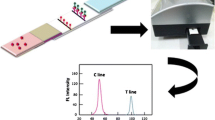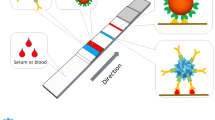Abstract
A model optical immunosensor was developed to quantify an antibody present in a sample by measuring the fluorescence of Cyanine-5 conjugated with the antibody, using a competitive and a sandwich immunoreaction configuration, with the antigen immobilised in controlled pore glass beads. At pH 2, 94% of the antigen-antibody complex was dissociated, allowing reutilisation. Photobleaching had no effect on the fluorescence. This model system was used to detect Brucella sp. infection and could quantify anti-Brucella sp. antibodies in ovine serum samples in the range from 0.005 to 0.11 mg ml−1.
Similar content being viewed by others
References
Cruz H, Rosa C, Oliva A (2002) Immunosensors for diagnostic applications. Parasitol. Res. 88: S4–S7.
Dittrich P, Schwille P (2001) Photobleaching and stabilization of fluorophores used for single-molecule analysis with one-and two-photon excitation. Appl. Phys. B-Lasers O 73: 829–837.
Gruber H, Hahn C, Kada G, Riener C, Harás G, Ahrer W, Dax T, Knaus H (2000) Anomalous fluorescence enhancement of Cy3 and Cy3.5 versus anomalous fluorescence loss of Cy5 and Cy7 upon covalent linking to IgG and noncovalent binding to avidin. Bioconjugate Chem. 11: 696–704.
Holden M, Cremer P (2003) Light activated patterning of dyelabeled on surfaces. J. Am. Chem. Soc. 125: 8074–8075.
Oliva A, Cruz H, Rosa C (2001) Immunosensors for diagnostics. In: Sensors Update: Sensor Applications, vol. 9, H. Baltess, J. Hesse, J.G. Korvink, eds. Weinheim: Wiley-VCH, pp. 284–286.
Rosa C, Cruz H, Vidal M, Oliva A (2002) Optical biosensor based on nitrite reductase immobilised in controlled pore glass. Biosens. Bioelectron. 17: 45–52.
Stabel T, Casale E, Swaisgood H, Horton H (1992) Anti-IgG immobilized controlled-pore glass. Thionyl chloride-Actived Succinamidopropyl-glass as a covalent immobilization matrix. Appl. Biochem. Biotech. 36: 87–96.
Vidal M, Prata M, Santos S, Tavares T, Hossfeld J, Preininger C, Oliva A (2000) Fluorescence IgG immunosensor based on a micro flow cell containing controlled pore glass as immobilisation support. Analyst 125: 1387–1391.
Wijesuriya D (1994) Regeneration of immobilized antibodies on fiber optic probes. Biosens. Bioelectron. 9: 585–592.
Zhou L, Cass A (1991) Periplasmic binding protein based biosensors. 1. Preliminary study of maltose binding protein as sensing for maltose biosensor. Biosens. Bioelectron. 6: 445–450.
Author information
Authors and Affiliations
Rights and permissions
About this article
Cite this article
Silva, M., Cruz, H., Rossetti, O. et al. Development of an optical immunosensor based on the fluorescence of Cyanine-5 for veterinarian diagnostics. Biotechnology Letters 26, 993–997 (2004). https://doi.org/10.1023/B:BILE.0000030046.96039.e8
Issue Date:
DOI: https://doi.org/10.1023/B:BILE.0000030046.96039.e8




